This publication is available online at https://ised-isde.canada.ca/site/aerospace-defence/en.
To obtain a copy of this publication, or to receive it in an alternate format (Braille, large print, etc.), please contact:
Web Services Centre
Innovation, Science and Economic Development Canada
C.D. Howe Building
235 Queen Street
Ottawa, Ontario K1A 0H5
Canada
Telephone (toll-free in Canada): 1-800-328-6189
Telephone (international): 613-954-5031
TTY (for hearing impaired): 1-866-694-8389
Business hours: 8:30 a.m. to 5:00 p.m. (Eastern Time)
Email: ISED@canada.ca
Permission to Reproduce
Except as otherwise specifically noted, the information in this publication may be reproduced, in part or in whole and by any means, without charge or further permission from the Department of Industry, provided that due diligence is exercised in ensuring the accuracy of the information reproduced; that the Department of Industry is identified as the source institution; and that the reproduction is not represented as an official version of the information reproduced, or as having been made in affiliation with, or with the endorsement of, the Department of Industry.
For permission to reproduce the information in this publication for commercial purposes, please fill out the Application for Crown Copyright Clearance at www.ic.gc.ca/copyright-request or contact the Web Services Centre mentioned above.
© Her Majesty the Queen in Right of Canada, as represented by the Minister of Industry, 2022
Cat. No. Iu62-2E-PDF
ISSN 1913-0171
Aussi offert en français sous le titre Rapport sur l’état de l’industrie canadienne de la cybersécurité.

Report Objective
The objective of this report is to develop relevant, quality, and timely strategic information on Canadian production of cybersecurity goods and services, and to brief policy and industry decision makers.
Canada is the first country from the Organisation for Economic Co-operation and Development (OECD) to conduct an in-depth Government statistical agency survey on cybersecurity industry capabilities from the supplier perspective. This survey, complementary to Statistics Canada’s Canadian Survey of Cyber Security and Cybercrime (CSCSC) (user perspective), is supported by a multi-year collaborative analytics agreement with industry associations, including the Canadian Association of Defence and Security Industries (CADSI), the Council of Canadian Innovators (CCI) and TECHNATION Canada.
This analysis presents a statistical overview of Canadian cybersecurity industry activities in 2020, based on the most recently available data. As such, these findings provide insights into the state of Canada’s cybersecurity industry during the first year of the COVID-19 pandemic.
The next iteration of the biennial survey will measure 2022 industrial activities. Publication of the basic 2022 data by Statistics Canada is scheduled for early 2024.
Project Framework
Survey Refinement & Preparations (May 2020–February 2021):
- Consultation with industry, subject matter experts, defence and public security organizations, and policy makers on the research framework, and updating the targeted population and questionnaire
Data Development (March 2021–January 2022):
- Innovation, Science and Economic Development Canada (ISED)-sponsored Statistics Canada biennial survey measuring 2020 activities (first year of COVID-19) with completion of a legal requirement under the Statistics Act
- Previous data collection efforts measured 2018 with those findings summarised under a previous report
- The next round of data collection will measure 2022 industrial activities
- Data validation and firm-level imputation based on administrative and other data
Data Analysis (May 2022–September 2022):
- Economic impact estimation based on a methodology informed by experts at the OECD and Statistics Canada (See Annex 1)
- Data analytics and report structure development
Comparative Analysis, 2018–2020
Canada’s cybersecurity industry outperformed the broader Information and Communications Technologies (ICT) sector across industrial indicators between 2018 and 2020Footnote1
Figure 1: Performance of Key Variables, the Canadian Cybersecurity Industry vs. the Broader ICT Sector, (% Change, 2018-2020)

Economic Impact
Canada’s cybersecurity industry contributed over $3.2 billion in Gross Domestic Product (GDP) and 29,000 jobs across the Canadian economy in 2020
- Total economic activity supported by the Canadian cybersecurity industry increased by over $860 million in GDP and 6,900 jobs between 2018 and 2020
Figure 2: Economic Impact 2020
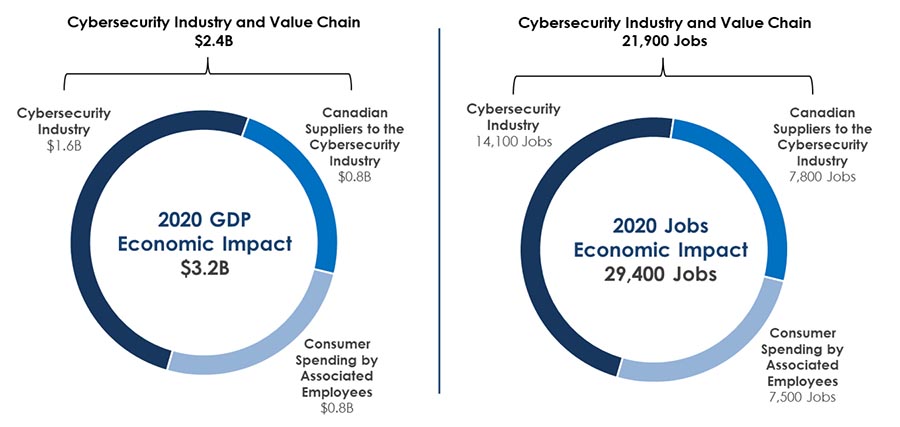
Size of Firm Footprint
Firms with fewer than 250 employees accounted for 90% of firms and 45% or more of revenues, employees, R&D, and exports
Figure 3: Size of Firm Footprint
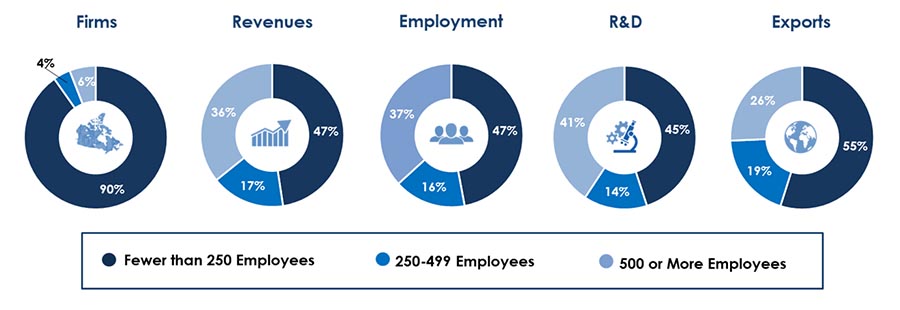
- Firms with 250-499 employees accounted for under 20% of revenues, employment, R&D, and exports
- Firms with 500+ employees accounted for over 35% of revenues, employment, and R&D, and as a group were the most R&D-oriented but least export-oriented
Ownership Type
Over 490 firms earned more than $3.7 billion in cybersecurity revenues, of which close to 85% were Canadian-owned in 2020Footnote2
Figure 4: Ownership Type
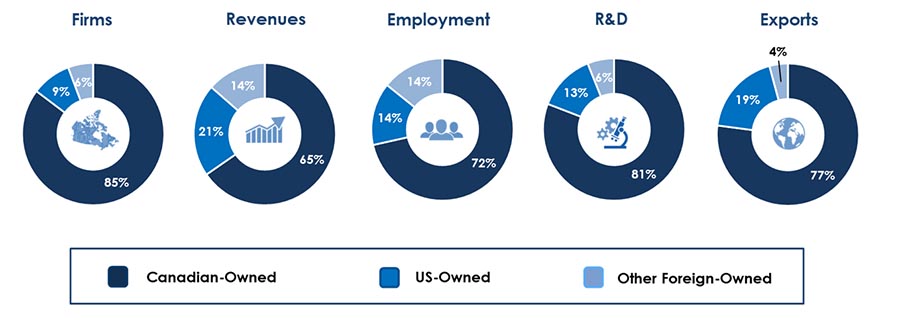
- Canadian-owned firms led in terms of revenues, employment, R&D, and exports
- The operations of foreign-owned firms were also notable and engaged in exports and R&D
Activities By Type
Total revenuesFootnote3 and growth were led by cyber infrastructure solutions for the ongoing protection of networks and data in 2020
- Beyond cyber infrastructure solutions, remaining industry revenues were fragmented across the provision of various other goods and services
Figure 5: Composition of Industry Revenues and Changes Between 2018 and 2020 by Goods and Services Type ($ Billions)

Regional Areas of Strength
Each region had specific areas of strength in 2020Footnote4
Figure 6: Canadian Cybersecurity Industry Employment Regional Breakdown with Top Regional Specializations 2020
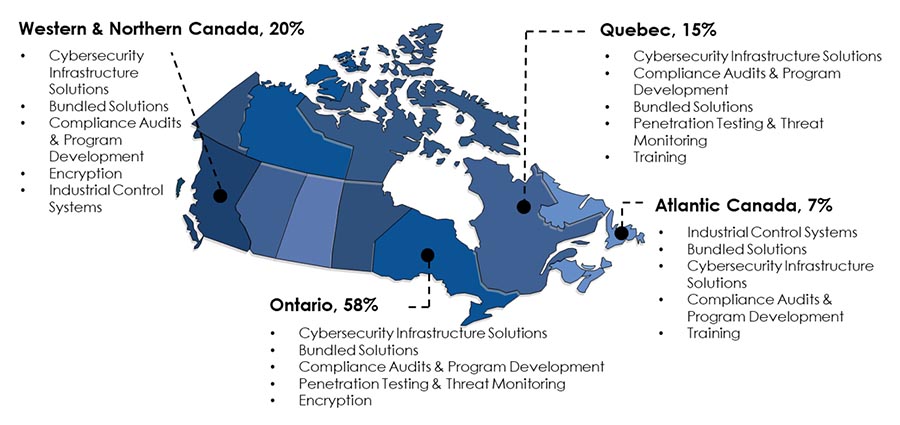
Skills/STEM
Science, Technology, Engineering & Mathematics (STEM)Footnote5 occupations led employment in the cybersecurity industry in 2020
Figure 7: Canadian Cybersecurity Industry Occupation & Gender Breakdown By Employment Type, 2020
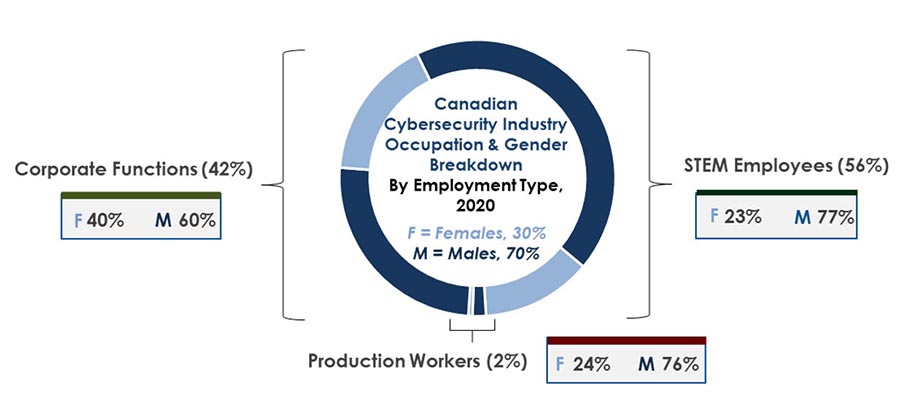
- STEM occupations’ share of cybersecurity industry employment was similar to that of the ICT industry and close to six times that of Canada’s overall industrial base
|
Occupation Type |
Canada's Cybersecurity Industry | Canada's ICT SectorFootnote6 |
|---|---|---|
|
Corporate FunctionsFootnote7 |
40% | 44% |
|
STEM |
23% | 21% |
| Production Workers | 24% | 16% |
|
TOTAL |
30% |
29% |
Innovation
The cybersecurity industry’s R&D intensityFootnote8 was close to 2.5 times greater than the Canadian ICT industry’s average in 2020
Figure 8: Canadian Cybersecurity Industry R&D Breakdown by Source of Funds and R&D Intensity Cybersecurity vs. ICT Industry (2020)
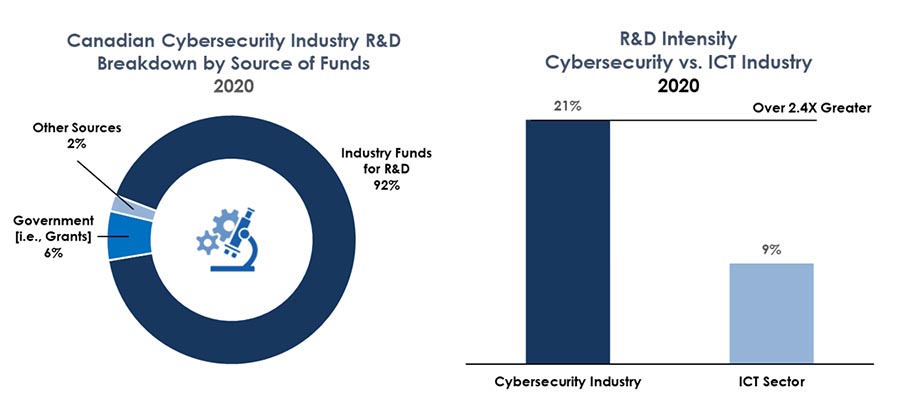
- Over $347 million of R&D was performed by the industry, led by experimental development in 2020
- More than 90% was funded by industry—led by funds from parent companies, affiliates, and subsidiaries of the cybersecurity industry R&D performers; followed by the internal funds of the R&D performersFootnote9.
Exports
Over $1.15 billion in exports, with close to 80% accounted for by Canada’s Five Eyes partnersFootnote10
- Export intensity was close to 2.5 times higher than the ICT industry average in 2020
Figure 9: Cybersecurity Industry Domestic Revenues vs. Exports 2020

Key Findings
In 2020, Canada’s cybersecurity industry:
- Outperformed the broader ICT sector across industrial indicators since 2018;
- Was led by Canadian-owned firms, and by firms with fewer than 250 employees;
- Contributed over 29,000 jobs to the Canadian economy,
- An increase of close to 6,900 jobs between 2018 and 2020;
- Was national in scope, with regional specializations; and,
- Was STEM-oriented and R&D-intensive, with over $1.15 billion of exports.
Annex
Annex 1: Economic Impact Methodology Principles
- Foundation data is from the latest (2020) Statistics Canada “Canadian Defence, Aerospace, Marine and Cybersecurity Industries Survey” released in 2022
- ISED economic modelling is based on Statistics Canada’s latest Input-Output multipliers (2018) and closest related specific economic impact multipliers that relate to cybersecurity activities
- Cybersecurity activity has been linked to the latest (2018) and most relevant specific economic impact multipliers per cybersecurity goods and services category
- GDP impact is reported cumulatively and on a yearly average basis
- Job impact is reported on an annual average basis and measured in terms of full-time equivalent employment (FTE)
- Jobs cannot be additive as they are maintained for an extended period after creation
- Total economic impact of the cybersecurity industry includes the activity that occurs within the Canadian cybersecurity industry, plus activity among Canadian suppliers to the Canadian cybersecurity industry, as well as consumer spending by associated employees across the Canadian economy
- Economic impact estimates are reported at the national level and cannot be broken down at the regional level
Data Sources
- Comparative Analysis, 2018–2020
- Statistics Canada’s Canadian Defence, Aerospace, Marine and Cybersecurity Industries Survey (2018, 2020), 2020 survey released in 2022
- ISED’s “2021 Canadian ICT Sector Profile” released in 2022
- Related ICT profile data from online and custom Statistics Canada data tables
- Economic Impact
- See 1(a)
- ISED economic modelling based on Statistics Canada’s latest input-output multipliers (2016 and 2018)
- Specific economic impact multipliers most relevant to the survey’s scope of cybersecurity goods and services
- Size of Firm Footprint
- See 1(a)
- Ownership Type
- See 1(a)
- Activities by Type
- See 1(a)
- Regional Areas of Strength
- See 1(a)
- Skills/STEM
- See 1(a)
- Statistics Canada custom tabulations based on the Labour Force Survey (2020), 2022
- Innovation
- See 1(a)
- ISED estimates of cybersecurity industry GDP
- See 1(b)
- See 1(c)
- Statistics Canada Table 36-10-0106-01 for GDP price indexes
- Exports
- See 1(a)
- See 1(b)
- See 1(c)

